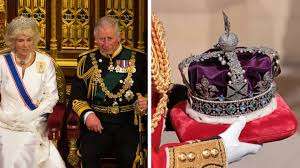
It has been announced by Buckingham Palace that King Charles III’s coronation will take place on Saturday 6 May 2023, at Westminster Abbey, and Camilla, the Queen Consort, will also be crowned in the same historic ceremony. He had become monarch when his mother Queen Elizabeth II, sadly passed away on Thursday 8 September, at her Balmoral Estate, in Scotland.
Her own coronation had taken place in June 1953, following the death of her father, King George VI, sixteen months earlier. This event therefore, will occur with a far shorter time lapse – 8 months to be precise – from when he was sworn in by a meeting of the Accession Council. It will also be the first to be held on a Saturday since Edward VII in 1902, when he succeeded Queen Victoria.
Possible modern twist?
With the usual pageantry and ritual that will undoubtedly have to be observed, the King will be anointed as sovereign and a crown placed on his head; but it has already been indicated that the ceremony will combine the established traditions with a more modern look towards the future, to reflect the new King’s role in today’s society.
Travel in the gold state coach
Although exact details will become public knowledge at a much later date, it is understood that the King will travel from Buckingham Palace to Westminster Abbey with his Queen Consort, Camilla and just like his mother and father, they are likely to be taken in the gold state coach, which is reserved for coronations and jubilees.
Archbishop of Canterbury to preside over ceremony
Coronations have been held at Westminster Abbey for more than 900 years, so the core elements of these public acts of constitutional symbolism will be hard to replace, if indeed they would even want to.
It is likely to include most of the rituals that have been in place for centuries, but maybe with a slightly lighter feel to acknowledge the “spirit of our times”. Her Majesty The Queen’s coronation took place at 11.15am and it is thought that this ceremony is likely to be in the morning too. What is almost certain even without clarification, is that the Archbishop of Canterbury will preside over the anointing, blessing, and consecration of King Charles III.
Shorter coronation expected
Back in 1953, nearly one million people travelled to London to watch the coach along the Mall and there is no reason to believe that sort of number will not be reached again this time around, possibly even higher. Nevertheless, it is being widely reported that the occasion will be much shorter, with it expected to last only just over an hour, as opposed to the extended three hours at Queen Elizabeth’s ceremony.
Far fewer to attend compared to previous ceremony
The guest list will also be greatly reduced. Gone are the temporary stands that were built inside the Abbey for the last coronation, with some of the rows of seating reaching a remarkable eleven tiers in height in the nave of the building. In total 8,250 people gained access to the event, one of them being a four year old Prince Charles, who was captured in a famous photograph, looking thoroughly bored with proceedings.
The current capacity of the Abbey is around 2,200, and that is what is expected to remain the limit for next year’s ceremony.
Sensitive approach to recognise cost-of-living crisis
Now that the announcement has been made much attention will be given to how the King might adapt the ceremony; possibly with the wording of his oath, or whether there will be a multi-faith element to the service.
It is expected that he will be sensitive to the appalling cost-of-living crisis that is hitting the nation hard. Charles will have a tricky balancing act in what to keep and what to allow to be withdrawn. He will of course have his Queen Consort, with him; she will be crowned as part of the service, in a similar fashion to the King, but on a much less grand scale.
Six-part process to coronation ceremony
There are usually six parts to a coronation ceremonial process: recognition, oath, anointing, investiture, enthronement and homage.
Recognition
The recognition sees the monarch stand in the theatre, which is the central part of the Abbey, and turn to the north, south, east and west to “show himself unto the people”. The Archbishop will then declare him the “undoubted King”, in a ritual dating back to Anglo-Saxon times.
Oath
The oath sees the King promise to reign according to law, exercise justice with mercy and maintain the Church of England. He will then be presented with the Sword of State and declare at the altar: “The things which I have here before promised, I will perform, and keep; so help me God,”, after which he will kiss the Bible and sign the oath.
Anointment
With regards to the anointing, this is the process of blessing and consecrating the new monarch with holy oil, basically the central act of the religious ceremony. The King will remove his crimson robe and sit in the 14th century King Edward’s Chair. It is then time for the investiture, which is the official crowning. This will see the King dressed in special robes and presented with the orb, coronation ring, sceptre, and rod.
Investiture and enthronement
Remaining seated in King Edward’s Chair, he will be crowned with the solid gold 17th century St Edward’s Crown, before the congregation shouts out ‘God Save the King’. This is followed by the enthroning, which will see the monarch lifted onto a different throne by archbishops, bishops and “other peers of the kingdom”. Whether there is any adaptations created at this stage, remains to be seen.
Homage
The final stage of the King’s coronation is known as homage. It sees the Archbishop of Canterbury, the Prince of Wales and other royal blood princes paying tribute to the King by placing their hands between his and kissing his right hand.
Possible procession
At the previous coronation, there followed a procession through the streets of London in the horse-drawn Gold State Coach, before making an appearance on the balcony of Buckingham Palace. There will be critics of this part, considering the amount of expense it will take to organise and conduct, but it is foreseen that this will continue, as the huge crowds expected to be in attendance, will demand it.
Same date as George V silver jubilee
It had been rumoured King Charles III would be crowned on the same date as his mother, which was 2 June, which no doubt would have been a special moment for him. The confirmed date however, 6 May, is the same as the first-ever Silver Jubilee when King George V celebrated 25 years on the throne, in 1935. It will also be the fourth birthday of his grandson Archie, the son of Prince Harry and Meghan Markle. Hopefully they will be able to make the ceremony.
Football fixtures could be affected
It is also a big day on the domestic football calendar, so officials will be anxiously awaiting confirmation of the final plans, as their scheduling could suddenly be in disarray, and an unexpected fixture congestion could cause them a major headache.
Bank holiday a likelihood
It is not yet known whether there will be an extra bank holiday added to the UK calendar. There is already one scheduled for the previous Monday, May 1. It could be that is now moved to the coronation weekend, and Monday 8 May becomes the bank holiday instead; it will all be announced in due course.












0 Comments